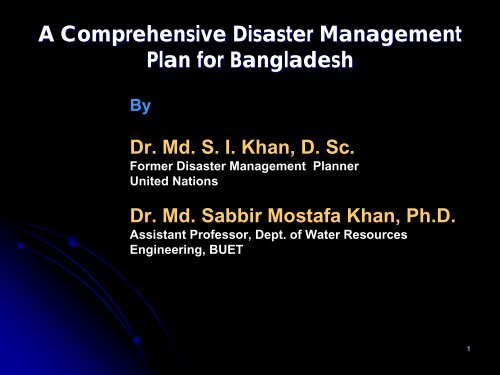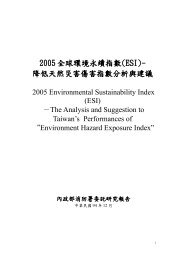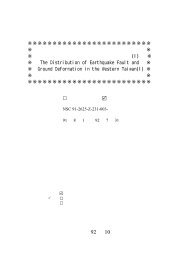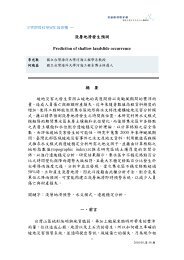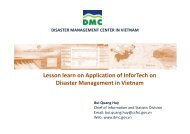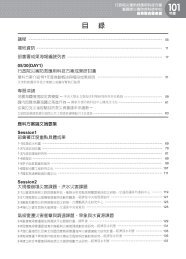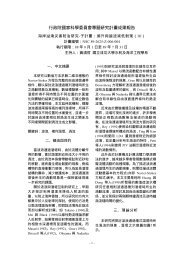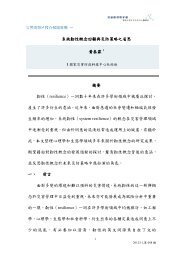A Comprehensive Disaster Management Plan for Bangladesh
A Comprehensive Disaster Management Plan for Bangladesh
A Comprehensive Disaster Management Plan for Bangladesh
You also want an ePaper? Increase the reach of your titles
YUMPU automatically turns print PDFs into web optimized ePapers that Google loves.
A <strong>Comprehensive</strong> <strong>Disaster</strong> <strong>Management</strong><br />
<strong>Plan</strong> <strong>for</strong> <strong>Bangladesh</strong><br />
By<br />
Dr. Md. S. I. Khan, D. Sc.<br />
Former <strong>Disaster</strong> <strong>Management</strong> <strong>Plan</strong>ner<br />
United Nations<br />
Dr. Md. Sabbir Mostafa Khan, Ph.D.<br />
Assistant Professor, Dept. of Water Resources<br />
Engineering, BUET<br />
1
Major hazards in <strong>Bangladesh</strong><br />
• Flood<br />
• Tidal surges/Tsunami<br />
• Cyclone<br />
• Drought<br />
• Earthquake<br />
• Limited Land Area and Enormous<br />
population<br />
• Diversion of <strong>Bangladesh</strong> water by India<br />
2
Flood Aggravation<br />
• Simultaneous heavy rainfall in the catchment<br />
areas of Ganges, Brambhaputra and Meghna<br />
• Temperature rise and excessive rainfall<br />
• Landslide and debris flow<br />
• High tide twice a day in the Bay of Bengal<br />
• Strong monsoon wind<br />
• Tsunami due to earthquake<br />
• Strong Al- Nino current<br />
3
Examples of some recent floods in<br />
<strong>Bangladesh</strong><br />
Event<br />
Natural<br />
Cause<br />
Manmade<br />
Duration<br />
days<br />
1987 flood . Heavy rainfall<br />
. De<strong>for</strong>estation<br />
. Huge melting of<br />
snow<br />
30<br />
1988 flood 1998 flood<br />
. Simultaneous Heavy<br />
rainfall<br />
. Simultaneous Heavy<br />
rainfall<br />
. Tsunami<br />
. Al-Nino<br />
. De<strong>for</strong>estation 14<br />
. De<strong>for</strong>estation 70<br />
2004 flood . Heavy rainfall<br />
. Landslide dam<br />
. De<strong>for</strong>estation<br />
. Debris flow<br />
21<br />
7
Tidal Surge/Tsunami<br />
• In 1998 tsunami caused by earthquake<br />
near Andaman Islands in Bay of Bengal<br />
prolonged flood duration in <strong>Bangladesh</strong><br />
• December 2004 tsunami near Sumatra<br />
traveled in east-west direction and as such<br />
<strong>Bangladesh</strong> escaped major disaster. Had<br />
the tsunami traveled in the north direction<br />
there would have been catastrophe in<br />
<strong>Bangladesh</strong>.<br />
8
Cyclone<br />
1970 Cyclone<br />
• Storm surge height = 8m<br />
• People killed = 500,000<br />
• Livestock perished: More than a million<br />
• Fishing boats destroyed: More than 60%<br />
1991 Cyclone<br />
• Storm surge height = 6m<br />
• People killed = 140,000<br />
• Livestock perished: More than a million<br />
• Many Fishing boats destroyed<br />
9
Diversion of <strong>Bangladesh</strong> Water by India<br />
54 cross border rivers carry water to<br />
<strong>Bangladesh</strong> from China, Nepal, Bhutan and<br />
India<br />
Out of total surface water in <strong>Bangladesh</strong><br />
- Brahmaputra contributes = 51 %<br />
- Ganges contributes = 28 %<br />
- Meghna contributes = 14%<br />
93% = 93%<br />
Rainfall within <strong>Bangladesh</strong> contributes = 7 %<br />
100%<br />
10
Normal Flood and River Flow<br />
Normal flood and river flow are essential<br />
-To push back tidal sea water that enters inland<br />
-To recharge groundwater which depletes 5 m/year<br />
• Recharge takes place<br />
By normal flooding = 4 metre<br />
By local rainfall = 1 metre<br />
• Production of Aman paddy which is 20% of total rice<br />
• For maintaining fish habitat, bio-diversity, navigation<br />
• Supplying water <strong>for</strong> drinking household use, etc.<br />
12
Indian Projects <strong>for</strong> Water Diversion<br />
• India has already diverted water of 34 crossborder<br />
rivers of 54 rivers<br />
• By Farakka Barrage and Inter Basin River<br />
Linking Project India plans to divert all<br />
Ganges water both during rainy and dry<br />
seasons<br />
• India plans to construct a dam near Dhubri in<br />
Assam to divert all Brahmaputra water under<br />
Inter Basin River Linking Project<br />
• India has started construction of a dam at<br />
Tipaimukh upstream of Meghna river in India<br />
which will cut off major flow of the Meghna<br />
river<br />
13
Indian Projects (Continued).....<br />
As a result of diversion of water by India<br />
• Sea water will enter deep inside<br />
<strong>Bangladesh</strong> and gradually turn <strong>Bangladesh</strong><br />
into desert due to salinity effect<br />
• Surface and groundwater will not be<br />
available <strong>for</strong> drinking, household use,<br />
irrigation, fisheries, livestock, industrial use<br />
and <strong>for</strong> other purposes<br />
• Vegetation, bio-diversity, environment and<br />
ecological balance will be destroyed<br />
• Natural fish habitat will be destroyed<br />
• Plunge entire nation into poverty, hunger. 15
Fronts of <strong>Disaster</strong> <strong>Management</strong> <strong>Plan</strong><br />
16
<strong>Disaster</strong> <strong>Management</strong> <strong>Plan</strong><br />
Following <strong>Disaster</strong> <strong>Management</strong> <strong>Plan</strong> is<br />
proposed <strong>for</strong> <strong>Bangladesh</strong> in the<br />
following 3 fronts<br />
1. Outside <strong>Bangladesh</strong>/Himalayan Front<br />
• There should be regional cooperation<br />
between all riparian countries namely<br />
China, Nepal, Bhutan, India and<br />
<strong>Bangladesh</strong>. There should be political<br />
agreement first. Reservoirs can be<br />
created in The Himalayas to store<br />
excess flood water and release it during<br />
drought.<br />
17
<strong>Disaster</strong> <strong>Management</strong> <strong>Plan</strong> (Continued)<br />
• Water may be shared among all riparian<br />
countries by signing a treaty in spirit of<br />
regional cooperation. Indus Basin Treaty<br />
between India and Pakistan, Mekong River<br />
Commission, Danube river water sharing<br />
project among 11 European countries may<br />
be taken as examples.<br />
• UN Charter, Helsinki Convention and other<br />
International laws must be honoured<br />
18
<strong>Disaster</strong> <strong>Management</strong> <strong>Plan</strong> (continued)<br />
Within <strong>Bangladesh</strong>/Domestic Front<br />
• Quick Drainage of Flood Water: Roads,<br />
railways, habitations and other infrastructures<br />
should not obstruct free flow of flood water.<br />
• Integrated Flood Drainage Channel: To<br />
facilitate drainage of flood water an integrated<br />
channel network is to be developed by<br />
deepening the rivers. Dredging, explosives<br />
and river training works may be used.<br />
• This will require both mathematical and<br />
physical model study. BUET and RRI can work<br />
jointly.<br />
19
<strong>Disaster</strong> <strong>Management</strong> <strong>Plan</strong> (continued)<br />
Protection of Major Cities and Vital Facilities<br />
• Capital Dhaka is to be provided full<br />
protection by immediately constructing<br />
embankment along eastern periphery.<br />
• All big industrial areas are to be protected.<br />
• Airports are to be protected<br />
• All highways and roads connecting districts<br />
with Upazila are to be raised above HFL<br />
• All railways are to be raised above HFL<br />
• Power substation, water supply facilities<br />
godowns, etc are to protected<br />
• Community participation and local initiative<br />
are vital<br />
20
<strong>Disaster</strong> <strong>Management</strong> <strong>Plan</strong> (continued)<br />
Protection of Major Cities (continued)<br />
• Flood markers showing the highest flood level<br />
(HFL) are to be installed <strong>for</strong> using as reference<br />
points <strong>for</strong> development. One ward may be<br />
selected as pilot scheme and flood markers<br />
installed by DMB and BWDB.<br />
• For protection against earthquake hazard all<br />
buildings and structures to be constructed strong<br />
as per codes. Sufficient open space is to be<br />
provided in each locality<br />
• Action <strong>Plan</strong>s <strong>for</strong> Emergency Preparedness and<br />
Emergency Response are to be prepared <strong>for</strong><br />
each ward with community participation. To start<br />
with a flood prone ward can be selected as a<br />
model <strong>for</strong> such purpose.<br />
21
Damage of LGED Rural Infrastructures by<br />
2004 Flood<br />
(Reference: The <strong>Bangladesh</strong> Observer, 10 August 2004)<br />
Damaged<br />
• Roads: 16,135 km<br />
• Bridges: 21,691 meter<br />
• Growth Centres: : 231 Nos<br />
• Primary Schools: 17,686 Nos<br />
• Cross Dam: 301.22 km<br />
• Total cost of Damage = Tk 2000 crore<br />
• Estimated Time of repair = 3 years<br />
22
<strong>Disaster</strong> <strong>Management</strong> <strong>Plan</strong> (continued)<br />
<strong>Disaster</strong> <strong>Management</strong> <strong>for</strong> Rural Areas<br />
• Flood level markers are to be established. At<br />
least one Upazila may be selected as pilot<br />
scheme <strong>for</strong> installing flood markers.<br />
• Growth Centres are to be raised above HFL.<br />
• Rural industries, artisans, livestock, poultry,<br />
pond fisheries, etc should be safe against<br />
flooding.<br />
• Ensure safe drinking water.<br />
• Control spread of disease and epidemic.<br />
• Schools to be expanded upwards.<br />
• Road connecting UP Office with Upazila<br />
should be raised above HFL to ensure<br />
movement of people and goods throughout<br />
the year<br />
23
Flood Level Marker<br />
24
<strong>Disaster</strong> M’ment <strong>for</strong> Rural Areas (contd.)<br />
• In the flood plain vulnerable clustered<br />
homesteads are to be protected by constructing<br />
ring bundhs.<br />
• To protect against wind storm rural houses are to<br />
be strengthened by prefabricated RCC pillars and<br />
wooden bracings.<br />
• Resiliency of poor people should be increased by<br />
increasing their income and improving standard of<br />
living through massive poverty alleviation<br />
programmes.<br />
• Develop appropriate Coping Mechanism through<br />
local initiative as local community should be the<br />
first to attend disaster victims.<br />
25
Coastal Belt/Sea Front Problems<br />
• High tide twice a day retards flood water<br />
drainage.<br />
• Tsunami may cause widespread<br />
devastation and may also block flood<br />
water drainage.<br />
• Al-Nino tidal surge blocks river discharge.<br />
• Global warming raises sea water level.<br />
One metre rise will inundate 16% of total<br />
area of <strong>Bangladesh</strong> affecting about 20<br />
million people.<br />
• Cyclonic surge causes tremendous loss of<br />
lives and properties.<br />
26
Sea Front Opportunity<br />
Bay Cross Dam<br />
A dam constructed from Cox’s Bazar to Patuakhali<br />
across Bay of Bengal will have following benefits.<br />
• Protect against cyclonic surge<br />
• Protect against tsunami and tidal surge<br />
• Protect against sea level rise due to global<br />
warming<br />
• Retain water in river network during dry season<br />
• Prevent sea water salinity intrusion<br />
• The rivers in <strong>Bangladesh</strong> carry about 2 billion<br />
tons of sediment every year which will be trapped<br />
by Bay Cross Dam and 25000 sq km land will be<br />
reclaimed in 30 years time.<br />
27
Sea Front Opportunity (continued)<br />
Bay Cross Dam Project Realization <strong>Plan</strong><br />
• Preparation of Project Concept Paper (PCP)<br />
• Establishment of Bay Cross Dam Authority<br />
• Feasibility Study– Preliminary<br />
• Model Study<br />
• Mathematical Model<br />
• Physical Model<br />
• Geo – technical, tidal hydraulics and other<br />
investigations<br />
• Environmental impact assessment<br />
• Seminar with participation of international<br />
experts<br />
• Feasibility Study – final<br />
29
Sea Front Opportunity (continued)<br />
Bay Cross Dam Project Realization <strong>Plan</strong> (continued)<br />
• Project Implementation<br />
• Phase I (Lower 12m)<br />
• Phase II (Upper 12m)<br />
• Lining up financial support<br />
• Construction of phase – I<br />
• Monitoring and evaluation<br />
• Updating of feasibility study<br />
• Prepare construction plan <strong>for</strong> phase – II<br />
• Construction of phase – II<br />
• Monitoring, evaluation and follow-up activities<br />
• Operation and maintenance.<br />
30
Sea Front Opportunity (continued)<br />
Vital Statistics of Bay Cross Dam<br />
• Length =100 miles (160 km)<br />
• Height = 24 m<br />
• Sea depth = 20 m<br />
• Main construction material = Boulders<br />
• Period of Implementation = 30 years<br />
• Land Reclamation = 25,000 sq. km<br />
31
Conclusion<br />
• DMB has produced excellent<br />
<strong>Disaster</strong> <strong>Management</strong> guidelines. If<br />
these guidelines are followed loss<br />
of lives and properties can be<br />
greatly reduced. But DMB has only<br />
one office which is located in<br />
Dhaka. DMB should open offices in<br />
all disaster prone Upazilas to<br />
accelerate the implementation of all<br />
disaster management initiatives.<br />
33
Conclusion (continued)<br />
• Cyclone Preparedness Programme<br />
(CPP) prepared by <strong>Bangladesh</strong> Red<br />
Crescent Society includes<br />
dissemination of cyclone warning,<br />
evacuating people to the shelters,<br />
services to the injured and post<br />
disaster rehabilitation, etc. Role of<br />
GOB and DMB in CPP is to be<br />
clearly specified.<br />
34
Conclusion (continued)<br />
• In addition to Cyclone Shelters<br />
Government may provide interest free<br />
house building loans to private families<br />
<strong>for</strong> constructing houses of 2 to 3<br />
stories.<br />
• Abnormal or high flood may occur once<br />
in 10 years and the country and people<br />
should be prepared to face it. This does<br />
not mean that all our flood water is to<br />
be diverted elsewhere and <strong>Bangladesh</strong><br />
is to be turned into a desert.<br />
35
Conclusion (continued)<br />
Normal flooding which inundates about<br />
20% of total area of <strong>Bangladesh</strong> is<br />
essential <strong>for</strong> the following reasons:<br />
• Pushing back saline water into the sea.<br />
• Recharging of groundwater and thereby<br />
ensuring production of HYV rice during<br />
dry season by tube-well irrigation.<br />
• Supplying water <strong>for</strong> drinking and<br />
household use.<br />
• Supplying water <strong>for</strong> industrial use.<br />
36
Conclusion (continued)<br />
Reasons (continued)<br />
• Supplying water <strong>for</strong> pond fisheries.<br />
• Preventing subsidence of low lying<br />
deltaic plain of <strong>Bangladesh</strong>.<br />
• Sustaining Aman paddy production.<br />
• Maintaining natural spawning grounds<br />
and fish habitats.<br />
• Maintaining bio-diversity, sustainable<br />
environment and ecological balance.<br />
• Poverty alleviation and improving<br />
quality of life.<br />
37
Conclusion (continued)<br />
• <strong>Disaster</strong> <strong>Management</strong> <strong>Plan</strong> and specially<br />
Emergency Preparedness and<br />
Emergency Response should be<br />
included in the school curricula to<br />
prepare our future generations to face<br />
disaster.<br />
• For the long term survival of<br />
<strong>Bangladesh</strong> immediate steps should be<br />
taken <strong>for</strong> realization of Bay Cross Dam<br />
Project. At present it may appear like a<br />
dream project, but some day this dream<br />
must come true.<br />
38
Thank You<br />
39


